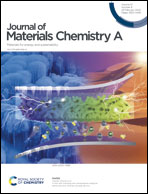Realizing electrochemical transformation of a metal–organic framework precatalyst into a metal hydroxide–oxy(hydroxide) active catalyst during alkaline water oxidation
Abstract
The facile and cost-effective designing of electrocatalysts still remains a challenge for electrochemical water oxidation. In the last three decades, a series of earth-abundant transition metal-based electrocatalysts have been explored for electrochemical water oxidation. In this regard, metal–organic framework (MOF) derived catalysts (metal oxides, phosphides, chalcogenides, etc.) with various compositions, desired morphologies, high porosity, large electrochemical surface areas, and tunable properties have been explored for electrochemical water oxidation. MOF-derived catalysts produce excellent electrochemical water oxidation activity in alkaline medium. However, the direct utilization of MOFs for anodic water oxidation has been overlooked for a long time due to their poor stability under electrochemical conditions. Recently, the instability of MOFs has been successfully utilized to produce ultrathin metal hydroxide–(oxy)hydroxide [M(OH)2–M(O)x(OH)y] nanosheets by electrochemical transformation. The MOF plays the role of a precatalyst and undergoes a series of structural reconstructions like hydrolysis, metal ion leaching, oxidation of the metal ions during alkaline anodic water oxidation and forms the active catalyst M(OH)2–M(O)x(OH)y. The electrochemically synthesized ultrathin nanosheets demonstrate excellent water oxidation activity and stability because of their atomic-level thickness, large electrochemical surface area, optimum inter-layer distance, and tuned electronic structure. Recently, this strategy has been explored to attain high-quality ultrathin M(OH)2–M(O)x(OH)y nanosheets for water oxidation. Although tremendous progress has been made in using MOFs as a precatalyst for electrochemical water oxidation, no dedicated review is available in this field. Looking at this point, this review describes a strategy of designing ultrathin M(OH)2–M(O)x(OH)y nanosheets by the electrochemical transformation of MOFs, the structural and electronic structure modulation of the ultrathin M(OH)2–M(O)x(OH)y nanosheets, morphological development and their application for electrochemical water oxidation. Moreover, the structure–activity–stability relationship has been established with suitable examples and the recent progress and challenges have also been addressed focusing on the future perspective in this field.



 Please wait while we load your content...
Please wait while we load your content...